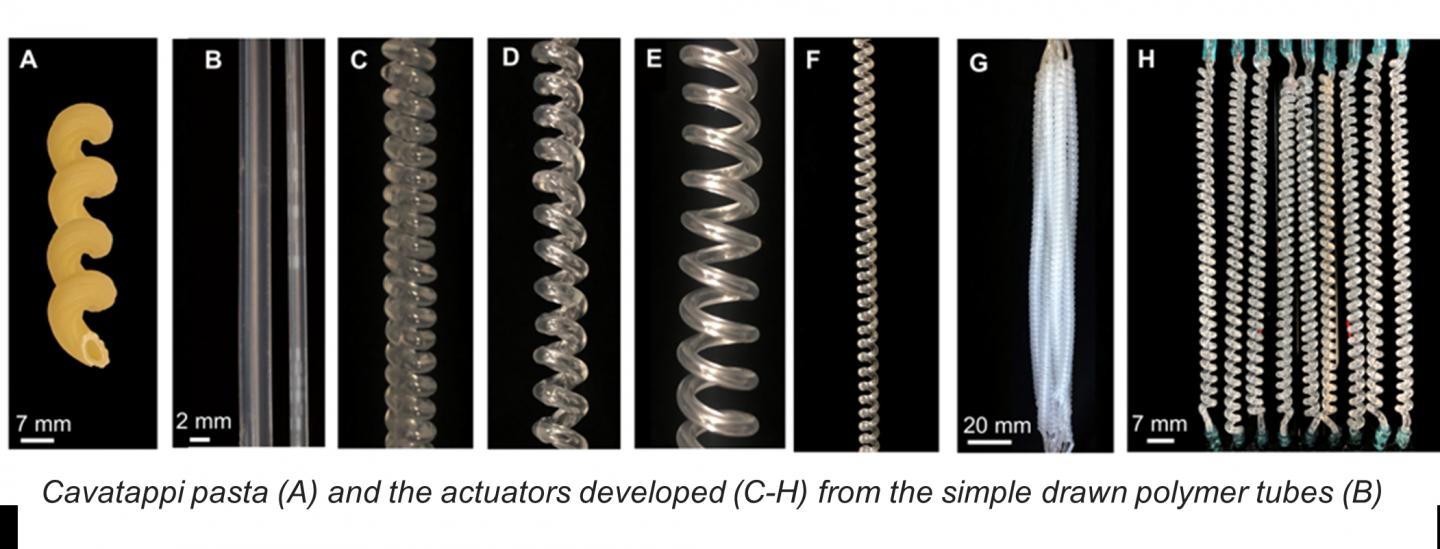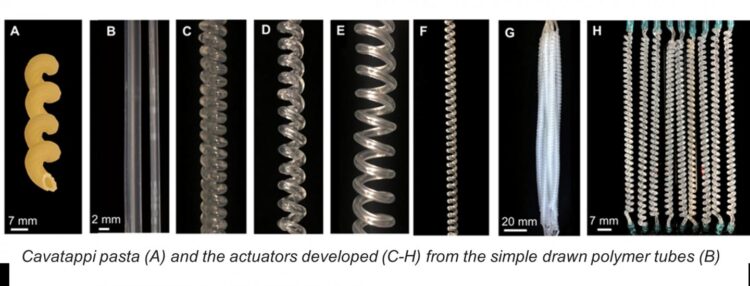‘Cavatappi’ artificial muscles, based on shape of Italian pasta, exhibit specific work and power metrics ten and five times higher than human skeletal muscles, respectively, and up to 45 percent efficiency

Credit: Northern Arizona University
In the field of robotics, researchers are continually looking for the fastest, strongest, most efficient and lowest-cost ways to actuate, or enable, robots to make the movements needed to carry out their intended functions.
The quest for new and better actuation technologies and ‘soft’ robotics is often based on principles of biomimetics, in which machine components are designed to mimic the movement of human muscles–and ideally, to outperform them. Despite the performance of actuators like electric motors and hydraulic pistons, their rigid form limits how they can be deployed. As robots transition to more biological forms and as people ask for more biomimetic prostheses, actuators need to evolve.
Associate professor (and alum) Michael Shafer and professor Heidi Feigenbaum of Northern Arizona University’s Department of Mechanical Engineering, along with graduate student researcher Diego Higueras-Ruiz, published a paper in Science Robotics presenting a new, high-performance artificial muscle technology they developed in NAU’s Dynamic Active Systems Laboratory. The paper, titled “Cavatappi artificial muscles from drawing, twisting, and coiling polymer tubes,” details how the new technology enables more human-like motion due to its flexibility and adaptability, but outperforms human skeletal muscle in several metrics.
“We call these new linear actuators cavatappi artificial muscles based on their resemblance to the Italian pasta,” Shafer said.
Because of their coiled, or helical, structure, the actuators can generate more power, making them an ideal technology for bioengineering and robotics applications. In the team’s initial work, they demonstrated that cavatappi artificial muscles exhibit specific work and power metrics ten and five times higher than human skeletal muscles, respectively, and as they continue development, they expect to produce even higher levels of performance.
“The cavatappi artificial muscles are based on twisted polymer actuators (TPAs), which were pretty revolutionary when they first came out because they were powerful, lightweight and cheap. But they were very inefficient and slow to actuate because you had to heat and cool them. Additionally, their efficiency is only about two percent,” Shafer said. “For the cavatappi, we get around this by using pressurized fluid to actuate, so we think these devices are far more likely to be adopted. These devices respond about as fast as we can pump the fluid. The big advantage is their efficiency. We have demonstrated contractile efficiency of up to about 45 percent, which is a very high number in the field of soft actuation.”
The engineers think this technology could be used in soft robotics applications, conventional robotic actuators (for example, for walking robots), or even potentially in assistive technologies like exoskeletons or prostheses.
“We expect that future work will include the use of cavatappi artificial muscles in many applications due to their simplicity, low-cost, lightweight, flexibility, efficiency and strain energy recovery properties, among other benefits,” Shafer said.
Technology is available for licensing, partnering opportunities
Working with the NAU Innovations team, the inventors have taken steps to protect their intellectual property. The technology has entered the protection and early commercialization stage and is available for licensing and partnering opportunities. For more information, please contact NAU Innovations.
Shafer joined NAU in 2013. His other research interests are related to energy harvesting, wildlife telemetry systems and unmanned aerial systems. Feigenbaum joined NAU in 2007, and her other research interest include ratcheting in metals and smart materials. The graduate student on this project, Diego Higueras-Ruiz, received his MS in Mechanical Engineering from NAU in 2018 and will be completing his PhD in Bioengineering in Fall 2021. This work has been supported through a grant from NAU’s Research and Development Preliminary Studies program.
###
About Northern Arizona University
Northern Arizona University is a higher-research institution providing exceptional educational opportunities in Arizona and beyond. NAU delivers a student-centered experience to its nearly 30,000 students in Flagstaff, statewide and online through rigorous academic programs in a supportive, inclusive and diverse environment. Dedicated, world-renowned faculty help ensure students achieve academic excellence, experience personal growth, have meaningful research opportunities and are positioned for personal and professional success.
Media Contact
Michael Shafer
[email protected]
Related Journal Article
http://dx.





